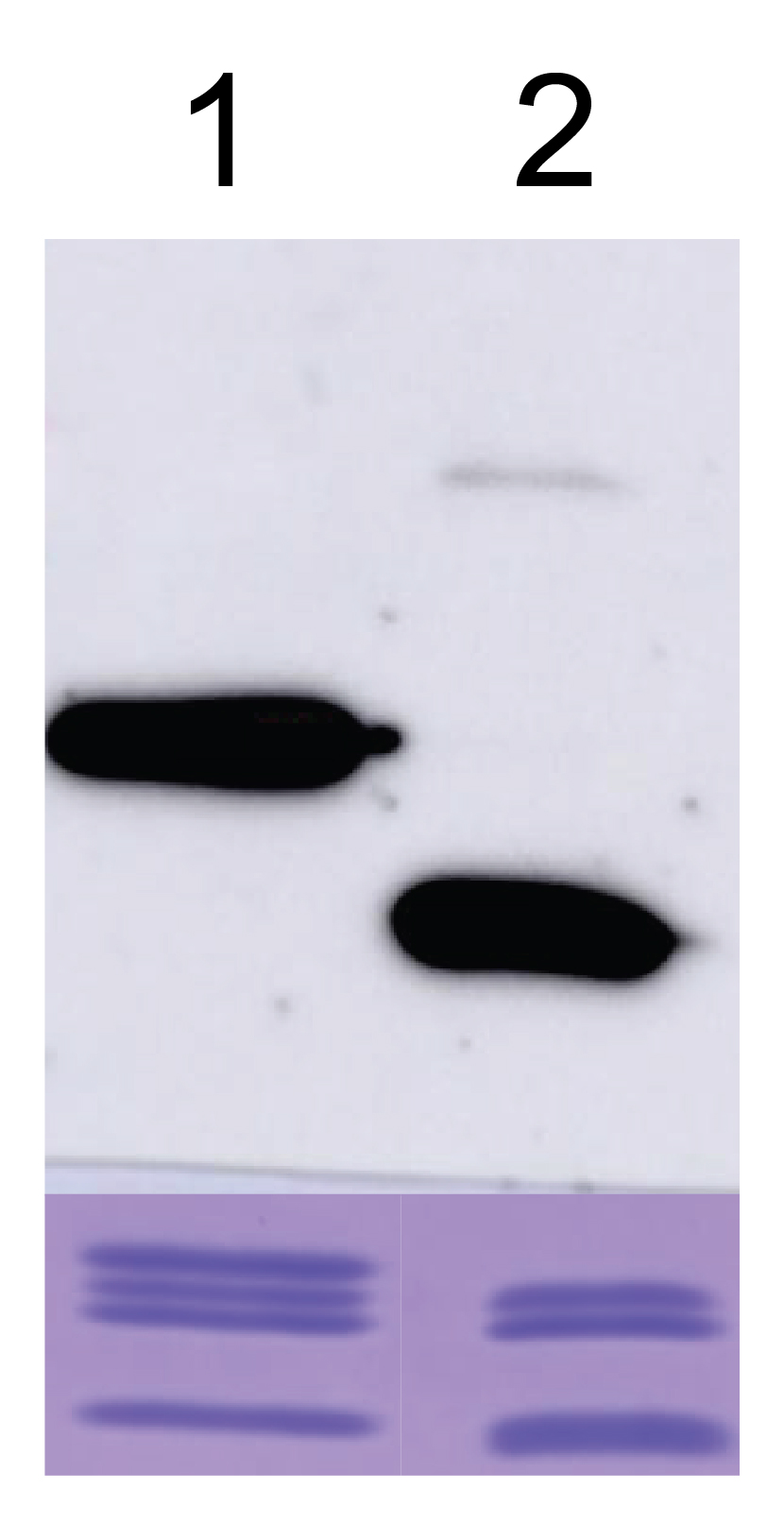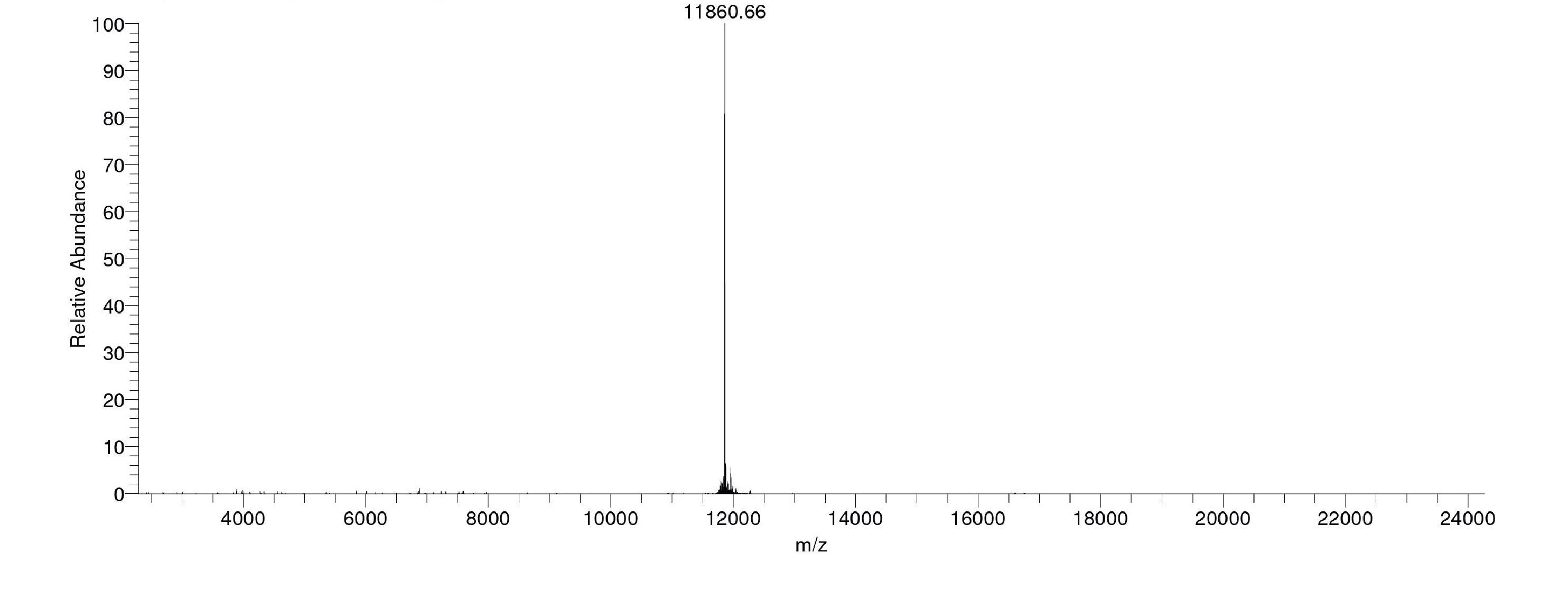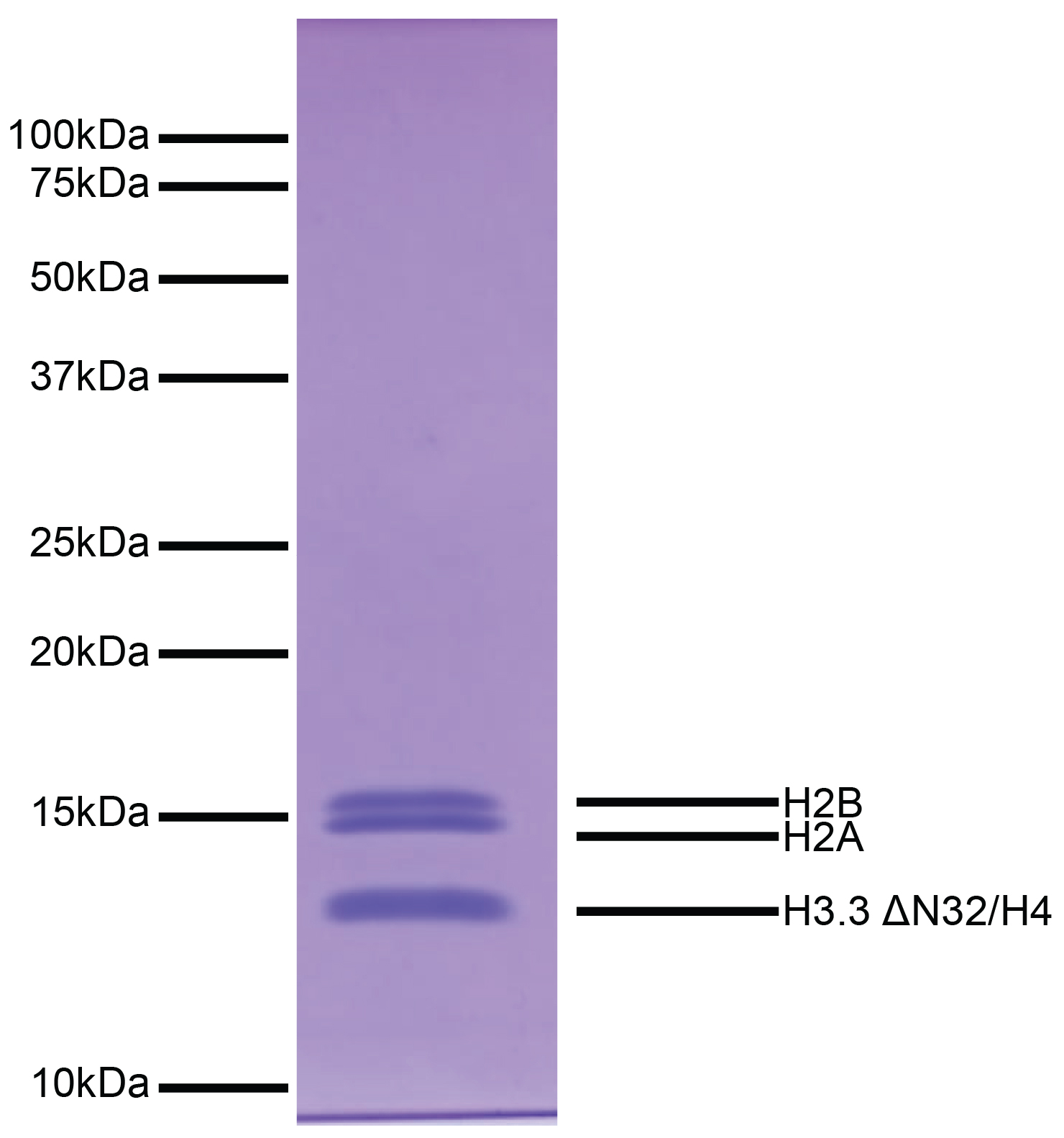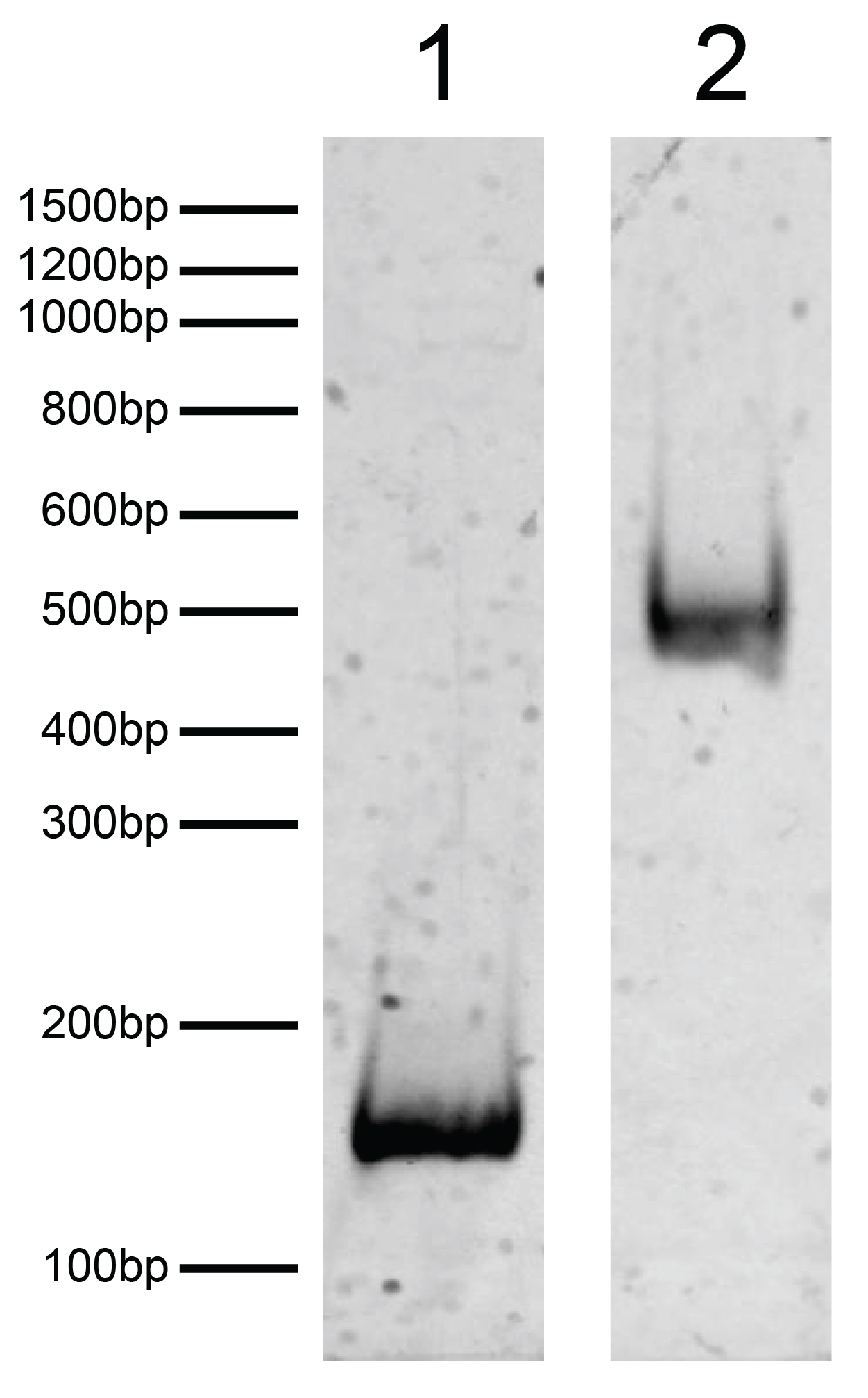

Mononucleosomes (H3.3 ΔN32), Recombinant Human
{"url":"https://www.epicypher.com/products/nucleosomes/recombinant-nucleosomes-rnucs/mononucleosomes-h3-3-n32-recombinant-human","add_this":[{"service":"facebook","annotation":""},{"service":"email","annotation":""},{"service":"print","annotation":""},{"service":"twitter","annotation":""},{"service":"linkedin","annotation":""}],"gtin":"","id":"534","bulk_discount_rates":[],"can_purchase":true,"meta_description":"Mononucleosomes (H3.3 ΔN32), Recombinant Human Biotinylated for Enzyme Screening","category":["Nucleosomes/Recombinant Nucleosomes (rNucs)"],"AddThisServiceButtonMeta":"","main_image":{"data":"https://cdn11.bigcommerce.com/s-y9o92/images/stencil/{:size}/products/534/382/Histone_variant_nucleosome__25014.1515789719.1280.1280__28607.1525791275.gif?c=2","alt":"Mononucleosomes (H3.3 ΔN32), Recombinant Human"},"add_to_wishlist_url":"/wishlist.php?action=add&product_id=534","shipping":{"calculated":true},"num_reviews":0,"weight":"0.01 LBS","custom_fields":[{"id":"607","name":"Pack Size","value":"50 µg"}],"sku":"16-1017","description":"<div class=\"product-general-info\">\n <ul class=\"product-general-info__list-left\">\n <li class=\"product-general-info__list-item\">\n <strong>Species: </strong>Human\n </li>\n <li class=\"product-general-info__list-item\">\n <strong>Source: </strong><em>E. coli</em> & synthetic DNA\n </li>\n </ul>\n <ul class=\"product-general-info__list-right\">\n <li class=\"product-general-info__list-item\">\n <strong>Tag: </strong>None\n </li>\n <li class=\"product-general-info__list-item\">\n <strong>Molecular Weight: </strong>192,436.8 Da.\n </li>\n </ul>\n</div>\n\n<div class=\"service_accordion product-droppdown\">\n <div class=\"container\">\n <div id=\"prodAccordion\">\n <div id=\"ProductDescription\" class=\"Block Panel current\">\n <h3 class=\"sub-title1\">Description</h3>\n <div\n class=\"ProductDescriptionContainer product-droppdown__section-description-specific\"\n >\n <p>\n Recombinant mononucleosomes (H3.3 ΔN32) consist of 147 base pairs of DNA wrapped around an octamer core of histone\nproteins (two each of H2A, H2B, H3.3 and H4) to form a nucleosome, the basic repeating unit of chromatin. The 147 bp 601\nsequence, identified by Lowary and Widom [1], has high affinity for histone octamers and is useful for nucleosome assembly.\nThe amino acid sequence for H3.3 in H3.3 ΔN32 dNuc begins with glycine 33 (amino acids 1-32 are deleted).\n </p>\n </div>\n </div>\n </div>\n <div id=\"prodAccordion\">\n <div id=\"ProductDescription\" class=\"Block Panel current\">\n <h3 class=\"sub-title1\">Validation Data</h3>\n <div\n class=\"ProductDescriptionContainer product-droppdown__section-description-specific\"\n >\n <section class=\"image-picker\">\n <div class=\"image-picker__left\">\n <div\n class=\"image-picker__main-content_active image-picker__main-content\"\n >\n <div class=\"image-picker__header-content\">\n <button class=\"image-picker__left-arrow\">\n <svg\n class=\"image-picker__svg-left\"\n width=\"24\"\n height=\"24\"\n viewBox=\"0 0 24 24\"\n >\n <path\n d=\"M16.67 0l2.83 2.829-9.339 9.175 9.339 9.167-2.83 2.829-12.17-11.996z\"\n />\n </svg>\n </button>\n <a\n href=\"https://cdn11.bigcommerce.com/s-y9o92/images/stencil/original/image-manager/16-1017-1.jpeg?t=1699413699\"\n target=\"_blank\"\n class=\"image-picker__main-image-link\"\n ><img\n alt=\"16-0389-western-blot-data\"\n src=\"https://cdn11.bigcommerce.com/s-y9o92/images/stencil/original/image-manager/16-1017-1.jpeg?t=1699413699\"\n class=\"image-picker__main-image\"\n />\n <span class=\"image-picker__main-image-caption\"\n >(Click to enlarge)</span\n ></a\n >\n <button class=\"image-picker__right-arrow\">\n <svg\n class=\"image-picker__svg-right\"\n width=\"24\"\n height=\"24\"\n viewBox=\"0 0 24 24\"\n >\n <path\n d=\"M7.33 24l-2.83-2.829 9.339-9.175-9.339-9.167 2.83-2.829 12.17 11.996z\"\n />\n </svg>\n </button>\n </div>\n <p>\n <span class=\"image-picker__span-content\"\n ><strong>Figure 1: Western blot data </strong><br />\n Western analysis of H3.3 ΔN32 dNuc. <strong>Top Panel</strong>: H3.3\nWild type (WT; Lane 1) and H3.3 ΔN32-containing nucleosomes (Lane 2) were\nprobed with an anti-H3 COOH-terminal antibody and analyzed via ECL readout.\n<strong>Bottom Panel</strong>: Detail from Coomassie stained gel showing histones from H3.3 WT\n(Lane 1) and H3.3 ΔN32 nucleosomes (Lane 2).\n </span>\n </p>\n </div>\n <div class=\"image-picker__main-content\">\n <div class=\"image-picker__header-content\">\n <button class=\"image-picker__left-arrow\">\n <svg\n class=\"image-picker__svg-left\"\n width=\"24\"\n height=\"24\"\n viewBox=\"0 0 24 24\"\n >\n <path\n d=\"M16.67 0l2.83 2.829-9.339 9.175 9.339 9.167-2.83 2.829-12.17-11.996z\"\n />\n </svg>\n </button>\n <a\n href=\"https://cdn11.bigcommerce.com/s-y9o92/images/stencil/original/image-manager/16-1017-2.jpeg?t=1699413700\"\n target=\"_blank\"\n class=\"image-picker__main-image-link\"\n ><img\n alt=\"16-0389-mass-spec-data\"\n src=\"https://cdn11.bigcommerce.com/s-y9o92/images/stencil/original/image-manager/16-1017-2.jpeg?t=1699413700\"\n class=\"image-picker__main-image\"\n />\n <span class=\"image-picker__main-image-caption\"\n >(Click to enlarge)</span\n ></a\n >\n <button class=\"image-picker__right-arrow\">\n <svg\n class=\"image-picker__svg-right\"\n width=\"24\"\n height=\"24\"\n viewBox=\"0 0 24 24\"\n >\n <path\n d=\"M7.33 24l-2.83-2.829 9.339-9.175-9.339-9.167 2.83-2.829 12.17 11.996z\"\n />\n </svg>\n </button>\n </div>\n <p>\n <span class=\"image-picker__span-content\"\n ><strong>Figure 2: Mass spec data </strong><br />\n Synthetic H3.3 ΔN32 histone analyzed by high resolution\nmass spectrometry. Expected mass = 11,860.85 Da. Determined mass = 11,860.66\nDa.\n </span>\n </p>\n </div>\n <div class=\"image-picker__main-content\">\n <div class=\"image-picker__header-content\">\n <button class=\"image-picker__left-arrow\">\n <svg\n class=\"image-picker__svg-left\"\n width=\"24\"\n height=\"24\"\n viewBox=\"0 0 24 24\"\n >\n <path\n d=\"M16.67 0l2.83 2.829-9.339 9.175 9.339 9.167-2.83 2.829-12.17-11.996z\"\n />\n </svg>\n </button>\n <a\n href=\"https://cdn11.bigcommerce.com/s-y9o92/images/stencil/original/image-manager/16-1017-3.jpeg?t=1699413701\"\n target=\"_blank\"\n class=\"image-picker__main-image-link\"\n ><img\n alt=\"16-0389-protein-gel-data\"\n src=\"https://cdn11.bigcommerce.com/s-y9o92/images/stencil/original/image-manager/16-1017-3.jpeg?t=1699413701\"\n class=\"image-picker__main-image\"\n />\n <span class=\"image-picker__main-image-caption\"\n >(Click to enlarge)</span\n ></a\n >\n <button class=\"image-picker__right-arrow\">\n <svg\n class=\"image-picker__svg-right\"\n width=\"24\"\n height=\"24\"\n viewBox=\"0 0 24 24\"\n >\n <path\n d=\"M7.33 24l-2.83-2.829 9.339-9.175-9.339-9.167 2.83-2.829 12.17 11.996z\"\n />\n </svg>\n </button>\n </div>\n <p>\n <span class=\"image-picker__span-content\"\n ><strong>Figure 3: Protein gel data</strong><br />\n Coomassie stained SDS-PAGE gel of proteins in\nH3.3 ΔN32 dNuc (1 µg) demonstrates the purity of histones in the preparation. Sizes\nof molecular weight markers and positions of the core histones (H2A, H2B,\nH3.3 ΔN32 and H4) are indicated. H3.3 ΔN32 and H4 co-migrate.\n </span>\n </p>\n </div>\n <div class=\"image-picker__main-content\">\n <div class=\"image-picker__header-content\">\n <button class=\"image-picker__left-arrow\">\n <svg\n class=\"image-picker__svg-left\"\n width=\"24\"\n height=\"24\"\n viewBox=\"0 0 24 24\"\n >\n <path\n d=\"M16.67 0l2.83 2.829-9.339 9.175 9.339 9.167-2.83 2.829-12.17-11.996z\"\n />\n </svg>\n </button>\n <a\n href=\"https://cdn11.bigcommerce.com/s-y9o92/images/stencil/original/image-manager/16-1017-4.jpeg?t=1699413702\"\n target=\"_blank\"\n class=\"image-picker__main-image-link\"\n ><img\n alt=\"16-0389-dna-gel-data\"\n src=\"https://cdn11.bigcommerce.com/s-y9o92/images/stencil/original/image-manager/16-1017-4.jpeg?t=1699413702\"\n class=\"image-picker__main-image\"\n />\n <span class=\"image-picker__main-image-caption\"\n >(Click to enlarge)</span\n ></a\n >\n <button class=\"image-picker__right-arrow\">\n <svg\n class=\"image-picker__svg-right\"\n width=\"24\"\n height=\"24\"\n viewBox=\"0 0 24 24\"\n >\n <path\n d=\"M7.33 24l-2.83-2.829 9.339-9.175-9.339-9.167 2.83-2.829 12.17 11.996z\"\n />\n </svg>\n </button>\n </div>\n <p>\n <span class=\"image-picker__span-content\"\n ><strong>Figure 4: DNA gel data</strong><br />\n H3.3 ΔN32 dNuc resolved via native PAGE gel and stained\nwith ethidium bromide to visualize DNA. <strong>Lane 1</strong>: Free DNA (EpiCypher <a href=\"https://www.epicypher.com/products/nucleosomes/nucleosome-components-and-subunits/nucleosome-assembly-601-sequence-dna\" target=\"_blank\">18-0006</a>;\n100 ng). <strong>Lane 2</strong>: Intact H3.3 ΔN32 nucleosomes (400 ng).\n </span>\n </p>\n </div>\n </div>\n <aside class=\"image-picker__right\">\n <div class=\"image-picker__gallery\">\n <img\n alt=\"16-0389-western-blot-data\"\n src=\"https://cdn11.bigcommerce.com/s-y9o92/images/stencil/original/image-manager/16-1017-1.jpeg?t=1699413699\"\n width=\"200\"\n class=\"image-picker__side-image image-picker__side-image_active\"\n role=\"button\"\n />\n <img\n alt=\"16-0389-mass-spec-data\"\n src=\"https://cdn11.bigcommerce.com/s-y9o92/images/stencil/original/image-manager/16-1017-2.jpeg?t=1699413700\"\n width=\"200\"\n class=\"image-picker__side-image image-picker__side-image_active\"\n role=\"button\"\n />\n <img\n alt=\"16-0389-protein-gel-data\"\n src=\"https://cdn11.bigcommerce.com/s-y9o92/images/stencil/original/image-manager/16-1017-3.jpeg?t=1699413701\"\n width=\"200\"\n class=\"image-picker__side-image image-picker__side-image_active\"\n role=\"button\"\n />\n <img\n alt=\"16-0389-dna-gel-data\"\n src=\"https://cdn11.bigcommerce.com/s-y9o92/images/stencil/original/image-manager/16-1017-4.jpeg?t=1699413702\"\n width=\"200\"\n class=\"image-picker__side-image image-picker__side-image_active\"\n role=\"button\"\n />\n </div>\n </aside>\n </section>\n </div>\n </div>\n </div>\n <div id=\"prodAccordion\">\n <div id=\"ProductDescription\" class=\"Block Panel\">\n <h3 class=\"sub-title1\">Technical Information</h3>\n <div\n class=\"ProductDescriptionContainer product-droppdown__section-description\"\n >\n <div class=\"product-tech-info\">\n <div class=\"product-tech-info__line-item\">\n <div class=\"product-tech-info__line-item-left\">\n <b>Storage</b>\n </div>\n <div class=\"product-tech-info__line-item-right\">\n Stable for six months at -80°C from date of receipt. For best results, aliquot and avoid freeze/thaws\n </div>\n </div>\n <div class=\"product-tech-info__line-item\">\n <div class=\"product-tech-info__line-item-left\">\n <b>Formulation</b>\n </div>\n <div class=\"product-tech-info__line-item-right\">\n 10 mM Tris HCl pH 7.5, 1 mM EDTA, 25 mM NaCl, 2 mM\nDTT, 20% glycerol. (27.4 µg protein, 50 µg DNA + protein)\n </div>\n </div>\n </div>\n </div>\n </div>\n </div>\n <div id=\"prodAccordion\">\n <div id=\"ProductDescription\" class=\"Block Panel\">\n <h3 class=\"sub-title1\">Application Notes</h3>\n <div\n class=\"ProductDescriptionContainer product-droppdown__section-description\"\n >\n <p>\n H3.3 ΔN32 mononucleosome is highly purified and suitable for a variety of applications, including use as a substrate in\nenzyme assays, high-throughput screening and inhibitor testing, chromatin binding studies, protein-protein interaction assays,\nstructural studies, and in effector protein binding experiments. The N-terminal deletion allows for the study of the role of the\nN-terminus in many aspects of chromatin biology.\n </p>\n </div>\n </div>\n </div>\n <div id=\"prodAccordion\">\n <div id=\"ProductDescription\" class=\"Block Panel\">\n <h3 class=\"sub-title1\">Gene & Protein Information</h3>\n <div\n class=\"ProductDescriptionContainer product-droppdown__section-description\"\n >\n <div class=\"product-tech-info\">\n <div class=\"product-tech-info__line-item\">\n <div class=\"product-tech-info__line-item-left\">\n <b>UniProt ID</b>\n </div>\n <div class=\"product-tech-info__line-item-right\">\n <p style=\"margin-bottom: 0\">\n H2A - P04908 (alt. names: H2A type 1-B/E, H2A.2, H2A/a, H2A/m)\n </p>\n <p style=\"margin-bottom: 0\">\n H2B - O60814 (alt. names: H2B K, HIRA-interacting protein 1)\n </p>\n <p style=\"margin-bottom: 0\">H3.3 - P84243</p>\n <p>H4 - P62805</p>\n </div>\n </div>\n </div>\n </div>\n </div>\n </div>\n <div id=\"prodAccordion\">\n <div id=\"ProductDescription\" class=\"Block Panel\">\n <h3 class=\"sub-title1\">References</h3>\n <div\n class=\"ProductDescriptionContainer product-droppdown__section-description\"\n >\n <strong>Background References:</strong>\n <br />\n [1] Lowary & Widom <i>J. Mol. Biol.</i> (1998). PMID:\n <a\n href=\"https://pubmed.ncbi.nlm.nih.gov/9514715/\"\n title=\"New DNA sequence rules for high affinity binding to histone octamer and sequence-directed nucleosome positioning\"\n target=\"new\"\n >\n 9514715</a\n >\n </div>\n </div>\n </div>\n <div id=\"prodAccordion\">\n <div id=\"ProductDescription\" class=\"Block Panel\">\n <h3 class=\"sub-title1\">Documents & Resources</h3>\n <div\n class=\"ProductDescriptionContainer product-droppdown__section-description\"\n >\n <div class=\"product-documents\">\n <a\n href=\"/content/documents/tds/16-1017.pdf\"\n target=\"_blank\"\n class=\"product-documents__link\"\n >\n <svg\n version=\"1.1\"\n id=\"Layer_1\"\n xmlns=\"http://www.w3.org/2000/svg\"\n xmlns:xlink=\"http://www.w3.org/1999/xlink\"\n x=\"0px\"\n y=\"0px\"\n viewBox=\"0 0 228 240\"\n style=\"enable-background: new 0 0 228 240\"\n xml:space=\"preserve\"\n class=\"product-documents__icon\"\n alt=\"16-0030 Datasheet\"\n >\n <g>\n <path\n class=\"product-documents__svg-pdf\"\n d=\"M191.92,68.77l-47.69-47.69c-1.33-1.33-3.12-2.08-5.01-2.08H45.09C41.17,19,38,22.17,38,26.09v184.36\n c0,3.92,3.17,7.09,7.09,7.09h141.82c3.92,0,7.09-3.17,7.09-7.09V73.8C194,71.92,193.25,70.1,191.92,68.77z M177.65,77.06h-41.7\n v-41.7L177.65,77.06z M178.05,201.59H53.95V34.95h66.92v47.86c0,5.14,4.17,9.31,9.31,9.31h47.86V201.59z\"\n />\n </g>\n <rect\n x=\"20\"\n y=\"112\"\n class=\"product-documents__svg-background\"\n width=\"146\"\n height=\"76\"\n />\n <g>\n <path\n class=\"product-documents__svg-pdf\"\n d=\"M23.83,125.68h22.36c5.29,0,9.41,1.33,12.35,4c2.94,2.67,4.42,6.39,4.42,11.18c0,4.78-1.47,8.51-4.42,11.18\n c-2.94,2.67-7.06,4-12.35,4H34.59v18.29H23.83V125.68z M44.81,147.9c5.38,0,8.07-2.32,8.07-6.97c0-2.39-0.67-4.16-2-5.31\n c-1.33-1.15-3.36-1.73-6.07-1.73H34.59v14.01H44.81z\"\n />\n <path\n class=\"product-documents__svg-pdf\"\n d=\"M69.92,125.68h18.91c5.29,0,9.84,0.97,13.66,2.9c3.82,1.93,6.74,4.72,8.76,8.35\n c2.02,3.63,3.04,7.98,3.04,13.04c0,5.06-1,9.42-3,13.08c-2,3.66-4.91,6.45-8.73,8.38c-3.82,1.93-8.4,2.9-13.73,2.9H69.92V125.68z\n M88.07,165.63c10.35,0,15.52-5.22,15.52-15.66c0-10.4-5.17-15.59-15.52-15.59h-7.38v31.26H88.07z\"\n />\n <path\n class=\"product-documents__svg-pdf\"\n d=\"M122.57,125.68h32.84v8.49h-22.22v11.18h20.84v8.49h-20.84v20.49h-10.63V125.68z\"\n />\n </g>\n </svg>\n <span class=\"product-documents__info\">Technical Datasheet</span>\n </a>\n </div>\n </div>\n </div>\n </div>\n </div>\n</div>","tags":[],"warranty":"","price":{"without_tax":{"formatted":"$475.00","value":475,"currency":"USD"},"tax_label":"Sales Tax"},"detail_messages":"","availability":"","page_title":"Mononucleosomes (H3.3 ΔN32), Recombinant Human Biotinylated for Enzyme Screening","cart_url":"https://www.epicypher.com/cart.php","max_purchase_quantity":0,"mpn":"","upc":null,"options":[],"related_products":[{"id":515,"sku":"16-0017","name":"Mononucleosomes (H3.3 ΔN32), Recombinant Human Biotinylated","url":"https://www.epicypher.com/products/nucleosomes/recombinant-nucleosomes-rnucs/mononucleosomes-h3-3-n32-recombinant-human-biotinylated","availability":"","rating":null,"brand":{"name":null},"category":["Nucleosomes/Recombinant Nucleosomes (rNucs)"],"summary":" \n","image":{"data":"https://cdn11.bigcommerce.com/s-y9o92/images/stencil/{:size}/products/515/362/Histone_variant_nucleosome__25014.1515789719.1280.1280__99123.1520444123.gif?c=2","alt":"Mononucleosomes (H3.3 ΔN32), Recombinant Human Biotinylated"},"images":[{"data":"https://cdn11.bigcommerce.com/s-y9o92/images/stencil/{:size}/products/515/362/Histone_variant_nucleosome__25014.1515789719.1280.1280__99123.1520444123.gif?c=2","alt":"Mononucleosomes (H3.3 ΔN32), Recombinant Human Biotinylated"}],"date_added":"7th Mar 2018","pre_order":false,"show_cart_action":true,"has_options":false,"stock_level":null,"low_stock_level":null,"qty_in_cart":0,"custom_fields":[{"id":1043,"name":"Pack Size","value":"50 µg"},{"id":1044,"name":"Internal Comment","value":"Has Bulk in LG"}],"num_reviews":null,"weight":{"formatted":"0.01 LBS","value":0.01},"demo":false,"add_to_cart_url":"https://www.epicypher.com/cart.php?action=add&product_id=515","price":{"without_tax":{"currency":"USD","formatted":"$475.00","value":475},"tax_label":"Sales Tax"},"add_to_wishlist_url":"/wishlist.php?action=add&product_id=515"},{"id":321,"sku":"16-0323","name":"Mononucleosomes (H3.3 K27M), Recombinant Human","url":"https://www.epicypher.com/products/nucleosomes/mutant-nucleosomes/mononucleosomes-h3-3-k27m-recombinant-human","availability":"","rating":null,"brand":{"name":null},"category":["Nucleosomes/Mutant Nucleosomes","Nucleosomes/Mutant Nucleosomes/Oncogenic Nucleosomes (oncoNucs)"],"summary":" Mononucleosomes (H3.3 K27M), Recombinant Human Description: ","image":{"data":"https://cdn11.bigcommerce.com/s-y9o92/images/stencil/{:size}/products/321/288/oncoNuc__56366.1569012501.gif?c=2","alt":"Mononucleosomes (H3.3 K27M), Recombinant Human"},"images":[{"data":"https://cdn11.bigcommerce.com/s-y9o92/images/stencil/{:size}/products/321/288/oncoNuc__56366.1569012501.gif?c=2","alt":"Mononucleosomes (H3.3 K27M), Recombinant Human"}],"date_added":"31st Aug 2016","pre_order":false,"show_cart_action":true,"has_options":false,"stock_level":null,"low_stock_level":null,"qty_in_cart":0,"custom_fields":[{"id":163,"name":"Pack Size","value":"100 μg"}],"num_reviews":null,"weight":{"formatted":"0.01 LBS","value":0.01},"demo":false,"add_to_cart_url":"https://www.epicypher.com/cart.php?action=add&product_id=321","price":{"without_tax":{"currency":"USD","formatted":"$425.00","value":425},"tax_label":"Sales Tax"},"add_to_wishlist_url":"/wishlist.php?action=add&product_id=321"},{"id":249,"sku":"16-0011","name":"Mononucleosomes (H3.3), Human Recombinant Biotinylated","url":"https://www.epicypher.com/products/testtemp/mononucleosomes-h3-3-human-recombinant-biotinylated","availability":"","rating":null,"brand":{"name":null},"category":["Nucleosomes","Nucleosomes/Recombinant Nucleosomes (rNucs)","Nucleosomes/Variant Nucleosomes (vNucs)"],"summary":" Mononucleosomes (H3.3), Human Recombinant Biotinylated Description: ","image":{"data":"https://cdn11.bigcommerce.com/s-y9o92/images/stencil/{:size}/products/249/329/Histone_variant_nucleosome__25014.1516390310.gif?c=2","alt":"Mononucleosomes (H3.3), Human Recombinant Biotinylated"},"images":[{"data":"https://cdn11.bigcommerce.com/s-y9o92/images/stencil/{:size}/products/249/329/Histone_variant_nucleosome__25014.1516390310.gif?c=2","alt":"Mononucleosomes (H3.3), Human Recombinant Biotinylated"}],"date_added":"26th Oct 2015","pre_order":false,"show_cart_action":true,"has_options":false,"stock_level":null,"low_stock_level":null,"qty_in_cart":0,"custom_fields":[{"id":762,"name":"Pack Size","value":"50 μg"},{"id":763,"name":"Internal Comment","value":"Has Bulk - Not Included in Amount"}],"num_reviews":null,"weight":{"formatted":"0.01 LBS","value":0.01},"demo":false,"add_to_cart_url":"https://www.epicypher.com/cart.php?action=add&product_id=249","price":{"without_tax":{"currency":"USD","formatted":"$475.00","value":475},"tax_label":"Sales Tax"},"add_to_wishlist_url":"/wishlist.php?action=add&product_id=249"},{"id":254,"sku":"16-0012","name":"Mononucleosomes (H3.3), Human Recombinant","url":"https://www.epicypher.com/products/nucleosomes/mononucleosomes-h3-3-human-recombinant","availability":"","rating":null,"brand":{"name":null},"category":["Nucleosomes","Nucleosomes/Recombinant Nucleosomes (rNucs)","Nucleosomes/Variant Nucleosomes (vNucs)"],"summary":" Mononucleosomes (H3.3), Human Recombinant Description: ","image":{"data":"https://cdn11.bigcommerce.com/s-y9o92/images/stencil/{:size}/products/254/330/Histone_variant_nucleosome__69550.1516390310.gif?c=2","alt":"Mononucleosomes (H3.3), Human Recombinant"},"images":[{"data":"https://cdn11.bigcommerce.com/s-y9o92/images/stencil/{:size}/products/254/330/Histone_variant_nucleosome__69550.1516390310.gif?c=2","alt":"Mononucleosomes (H3.3), Human Recombinant"}],"date_added":"3rd Dec 2015","pre_order":false,"show_cart_action":true,"has_options":false,"stock_level":null,"low_stock_level":null,"qty_in_cart":0,"custom_fields":[{"id":128,"name":"Pack Size","value":"100 μg"}],"num_reviews":null,"weight":{"formatted":"0.01 LBS","value":0.01},"demo":false,"add_to_cart_url":"https://www.epicypher.com/cart.php?action=add&product_id=254","price":{"without_tax":{"currency":"USD","formatted":"$425.00","value":425},"tax_label":"Sales Tax"},"add_to_wishlist_url":"/wishlist.php?action=add&product_id=254"},{"id":514,"sku":"16-0016","name":"Mononucleosomes (H3.1 ΔN32), Recombinant Human Biotinylated","url":"https://www.epicypher.com/products/nucleosomes/recombinant-nucleosomes-rnucs/mononucleosomes-h3-1-n32-recombinant-human-biotinylated","availability":"","rating":null,"brand":{"name":null},"category":["Nucleosomes/Recombinant Nucleosomes (rNucs)"],"summary":"\n \n \n Species: Human\n \n \n Source: E. coli & synthetic DNA\n \n \n \n ","image":{"data":"https://cdn11.bigcommerce.com/s-y9o92/images/stencil/{:size}/products/514/360/Histone_variant_nucleosome__65083.1515789648.1280.1280__51889.1520432823.gif?c=2","alt":"Mononucleosomes (H3.1 ΔN32), Recombinant Human Biotinylated"},"images":[{"data":"https://cdn11.bigcommerce.com/s-y9o92/images/stencil/{:size}/products/514/360/Histone_variant_nucleosome__65083.1515789648.1280.1280__51889.1520432823.gif?c=2","alt":"Mononucleosomes (H3.1 ΔN32), Recombinant Human Biotinylated"}],"date_added":"7th Mar 2018","pre_order":false,"show_cart_action":true,"has_options":false,"stock_level":null,"low_stock_level":null,"qty_in_cart":0,"custom_fields":[{"id":606,"name":"Pack Size","value":"50 µg"}],"num_reviews":null,"weight":{"formatted":"0.01 LBS","value":0.01},"demo":false,"add_to_cart_url":"https://www.epicypher.com/cart.php?action=add&product_id=514","price":{"without_tax":{"currency":"USD","formatted":"$475.00","value":475},"tax_label":"Sales Tax"},"add_to_wishlist_url":"/wishlist.php?action=add&product_id=514"}],"shipping_messages":[],"rating":0,"meta_keywords":"Highly Purified Recombinant Nucleosomes for Enzyme Assays, Screening and Kinetics, recombinant nucleosome, recombinant chromatin, recombinant mononucleosomes, highly purified recombinant nucleosomes, human, biotinylated, 16-0017, nucleosome, n-terminal deletion, h3.1, Mononucleosomes (H3.3 ΔN32), Recombinant Human Biotinylated for Enzyme Screening","show_quantity_input":1,"title":"Mononucleosomes (H3.3 ΔN32), Recombinant Human","gift_wrapping_available":false,"min_purchase_quantity":0,"customizations":[],"images":[{"data":"https://cdn11.bigcommerce.com/s-y9o92/images/stencil/{:size}/products/534/382/Histone_variant_nucleosome__25014.1515789719.1280.1280__28607.1525791275.gif?c=2","alt":"Mononucleosomes (H3.3 ΔN32), Recombinant Human"}]} Pack Size: 50 µg
- Species: Human
- Source: E. coli & synthetic DNA
- Tag: None
- Molecular Weight: 192,436.8 Da.
Description
Recombinant mononucleosomes (H3.3 ΔN32) consist of 147 base pairs of DNA wrapped around an octamer core of histone proteins (two each of H2A, H2B, H3.3 and H4) to form a nucleosome, the basic repeating unit of chromatin. The 147 bp 601 sequence, identified by Lowary and Widom [1], has high affinity for histone octamers and is useful for nucleosome assembly. The amino acid sequence for H3.3 in H3.3 ΔN32 dNuc begins with glycine 33 (amino acids 1-32 are deleted).
Validation Data
Figure 1: Western blot data
Western analysis of H3.3 ΔN32 dNuc. Top Panel: H3.3
Wild type (WT; Lane 1) and H3.3 ΔN32-containing nucleosomes (Lane 2) were
probed with an anti-H3 COOH-terminal antibody and analyzed via ECL readout.
Bottom Panel: Detail from Coomassie stained gel showing histones from H3.3 WT
(Lane 1) and H3.3 ΔN32 nucleosomes (Lane 2).
Figure 2: Mass spec data
Synthetic H3.3 ΔN32 histone analyzed by high resolution
mass spectrometry. Expected mass = 11,860.85 Da. Determined mass = 11,860.66
Da.
Figure 3: Protein gel data
Coomassie stained SDS-PAGE gel of proteins in
H3.3 ΔN32 dNuc (1 µg) demonstrates the purity of histones in the preparation. Sizes
of molecular weight markers and positions of the core histones (H2A, H2B,
H3.3 ΔN32 and H4) are indicated. H3.3 ΔN32 and H4 co-migrate.
Figure 4: DNA gel data
H3.3 ΔN32 dNuc resolved via native PAGE gel and stained
with ethidium bromide to visualize DNA. Lane 1: Free DNA (EpiCypher 18-0006;
100 ng). Lane 2: Intact H3.3 ΔN32 nucleosomes (400 ng).
Technical Information
Application Notes
H3.3 ΔN32 mononucleosome is highly purified and suitable for a variety of applications, including use as a substrate in enzyme assays, high-throughput screening and inhibitor testing, chromatin binding studies, protein-protein interaction assays, structural studies, and in effector protein binding experiments. The N-terminal deletion allows for the study of the role of the N-terminus in many aspects of chromatin biology.
Gene & Protein Information
H2A - P04908 (alt. names: H2A type 1-B/E, H2A.2, H2A/a, H2A/m)
H2B - O60814 (alt. names: H2B K, HIRA-interacting protein 1)
H3.3 - P84243
H4 - P62805
References
[1] Lowary & Widom J. Mol. Biol. (1998). PMID: 9514715








